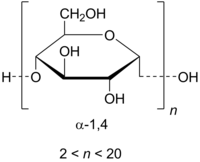
Photo from wikipedia
Differences between the levan obtained from bacteria and from cell-free systems were studied in this work. Results showed that both polymers are non-porous solids (type II isotherm with 20 m2/g)… Click to show full abstract
Differences between the levan obtained from bacteria and from cell-free systems were studied in this work. Results showed that both polymers are non-porous solids (type II isotherm with 20 m2/g) with a main thermal decomposition at 200 °C and a negligible value of protein adsorption. Microbial levan produced nanoparticles of 90 nm in diameter whereas nanoparticles of 110 nm were obtained with the polymer obtained from a cell-free system. Both polymers behave as aggregates depending on the critical aggregation concentration. At the same time, that concentration depends on the technique used for the polymer synthesis. Cell-free system aggregation concentration is 0.24 mg/mL whereas a concentration of 0.05 mg/mL was found for the microbial system. In both cases, the average molecular weight of the aggregate is higher than 2000 kDa. These results highlight the existence of aggregation equilibrium for both polymers that has to be taken into account for future applications.
Journal Title: International journal of biological macromolecules
Year Published: 2019
Link to full text (if available)
Share on Social Media: Sign Up to like & get
recommendations!